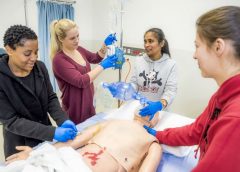One of the most important steps in achieving positive wound-healing outcomes is to choose the right wound care product. This can be tricky, challenging, and sometimes overwhelming—especially if you’re new to wound care. When I first started in wound care, I had four to five “go-to” products that I knew about. Beyond that, I had to guess what would work. But I learned one thing early: I could call on my sales representatives for help. (more…)
Read MoreMonth: February 2015
Medical gauze 101
By Nancy Morgan, RN, BSN, MBA, WOC, WCC, DWC, OMS
Each issue, Apple Bites brings you a tool you can apply in your daily practice.
Medical gauze, a bleached white cloth or fabric used in bandages, dressings, and surgical sponges, is the most widely used wound care dressing. Commonly known as “4×4s,” gauze is made from fibers of cotton, rayon, polyester, or a combination of these fibers. Surgical gauze must meet standards of purity, thread count, construction, and sterility according to the United States Pharmacopeia. (more…)
Read MoreCommunicating to caregivers: Cornerstone of care
By Jeri Lundgren, BSN, RN, PHN, CWS, CWCN
The challenge of preventing pressure ulcers is won through our frontline staff—the patient’s caregivers. Caregivers deliver most of the pressure ulcer preventive interventions, such as turning and repositioning, floating the heels, and managing incontinence. That’s why it’s imperative to communicate the patient’s plan of care directly to the caregivers. (more…)
Read MoreWhat does it mean to participate in a wound care clinical trial?
By Susan Beard, RN, BS, CWOCN
Suppose you’re reading an article on a new product that states the product has been through a series of clinical trials before marketing. What does this mean? Who was involved? As a clinician, could you initiate or be involved in a clinical trial of a new product? Who are clinical trial subjects, and what’s it like for them to be involved in a clinical study?
A clinical trial starts as an idea. As clinicians, we often use our critical-thinking skills to imagine a product or method of practice we think could be created or improved on to better meet our patients’ needs. The idea begins to grow and a series of events begins. (more…)
Read MoreHealthcare reform and changes provide opportunities for wound care clinicians
By Kathleen D. Schaum, MS
Qualified healthcare professionals (QHPs), such as physicians, podiatrists, physician assistants, nurse practitioners, and clinical nurse specialists, are taught to diagnose the reasons that chronic wounds aren’t healing and to create plans of care for aggressively managing the wound until it heals. Wound care professionals—nurses and therapists—are taught to implement those plans of care. All of these highly skilled wound care professionals know how to manage chronic wounds from identification through healing. (more…)
Read MoreClinician Resources: MRSA, Dosing Calculator, CDC Resources
Helping Sandwich Generation nurses find a work-life balance
By Kari Olson Finnegan, BSN, and Liz Ferron, MSW, LICSW
If you have at least one parent age 65 or older and are raising children or financially supporting a child age 18 or older, you’re part of the Sandwich Generation. Coined in 1981 by social worker Dorothy Miller, the term originally referred to women, generally in their 30s and 40s, who were “sandwiched” between young kids, spouses, employers, and aging parents. While the underlying concept remains the same, over time the definition has expanded to include men and to encompass a larger age range, reflecting the trends of delayed childbearing, grown children moving back home, and elderly parents living longer. The societal phenomenon of the Sandwich Generation increasingly is linked to higher levels of stress and financial uncertainty, as well as such downstream effects as depression and greater health impacts in caregivers. (more…)
Read MoreTranslating the language of health care
By Catherine E. Chung, PhD, RN, CNE, WCC
As a wound care clinician, you teach patients about medications, wound treatments, the plan of care, symptoms of complications, wound physiology—you teach a lot. And most patients probably smile and nod when you ask, “Do you understand?” However, health literacy research has shown that only 12% of the U.S. population is fluent in the language of health care. As health care has become increasingly complex, it has become increasingly difficult for patients to understand. Fortunately for your patient, you can translate. (more…)
Read MoreThe Buzz Report: A wound care clinician’s best friend
By Donna Sardina, RN, MHA, WCC, CWCMS, DWC, OMS
In 2014, more than 8,000 new articles related to wound healing were added to the PubMed online database and hundreds of new patents for topical wound formulations were filed. Staying up-to-date with the latest and greatest findings and products can be challenging. We all lead busy lives, and our demanding work schedules and home responsibilities can thwart our best intentions. Although we know it’s our responsibility to stay abreast of changes in our field, we may feel overwhelmed trying to make that happen. (more…)
Read MoreClinical Notes
Diabetes carries high economic burden
According to a study published in Diabetes Care, the economic burden associated with diagnosed diabetes (all ages) and undiagnosed diabetes, gestational diabetes, and prediabetes (adults) exceeded $322 billion in 2012, amounting to an economic burden exceeding $1,000 for each American. (more…)
Read MorePalliative wound care: Part 1
By Gail Rogers Hebert, MS, RN, CWCN, WCC, DWC, OMS, LNHA
The World Health Organization defines palliative care as “an approach that improves the quality of life of patients and their families facing the problem associated with life-threatening illness, through the prevention and relief of suffering by means of early identification and impeccable assessment and treatment of pain and other problems, physical, psychosocial and spiritual.” (more…)
Read More

